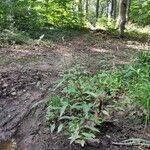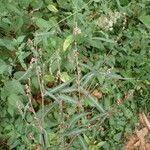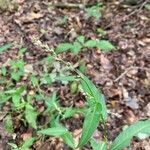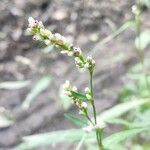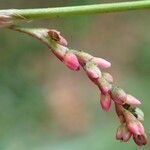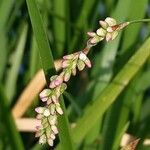Plants annual, 0.5-3(-4) dm; roots also sometimes at from proximal nodes; rhizomes and stolons absent. Stems decumbent or ascending, branched proximally, scarcely ribbed, glabrous or scabrous distally. Leaves: ocrea brownish, cylindric, 3-10 mm, chartaceous, base not inflated, margins truncate, ciliate with bristles (0.3-)1-3(-5) mm, surface glabrous or strigose, not glandular-punctate; petiole 0.1-0.2 cm, glabrous or strigose, leaves sometimes sessile; blade without dark triangular or lunate blotch adaxially, linear to linear-lanceolate, (1-)2-7.5(-10) × (0.2-)0.4-1(-2.3) cm, base tapered to cuneate, margins antrorsely scabrous, apex acute to acuminate, faces glabrous or sparingly strigose, especially along midveins, not glandular-punctate. Inflorescences terminal and axillary, ascending to erect, usually interrupted proximally, uninterrupted distally, 10-50 × 2-4 mm; peduncle (0-)2-25 mm, sometimes absent on axillary inflorescences and flowers thus enclosed in ocreae, glabrous; ocreolae not overlapping proximally, usually overlapping distally, margins ciliate with bristles (0.1-)0.6-2(-2.7) mm. Pedicels ascending, 0.5-1 mm. Flowers 1-3(-4) per ocreate fascicle, homostylous; perianth roseate to red, rarely white, glabrous, not glandular-punctate, scarcely accrescent; tepals 5, connate ca. 1/ 3 their length, obovate to elliptic, 2.5-3 mm, veins not prominent, not anchor-shaped, margins entire, apex obtuse to rounded; stamens 5(-6), included; anthers yellow to pink, elliptic; styles 2(-3), connate at bases. Achenes included, brownish black to black, biconvex or, rarely, 3-gonous, (1.5-)1.8-2.3(-2.7) × (1.1-)1.3-1.5(-1.8) mm, shiny, smooth.
More
An annual herb. It can also keep growing from year to year. It lies along the ground but can also reach to 1 m high. The stems are slender. They are 1-4 mm thick. The leaf stalks are short. The leaves are sword shaped or almost linear. They are 5-12 cm long. The leaves are hairy underneath. The flowering arrangement is at the top. There are 1 or more lax false spikes. These are 1-6 cm long. There are 3-6 flowers and the bracts are funnel shaped. The fruit are lens shaped with faces which curve outwards. They are 1.5-2 mm long. They are black or brown and shiny.
